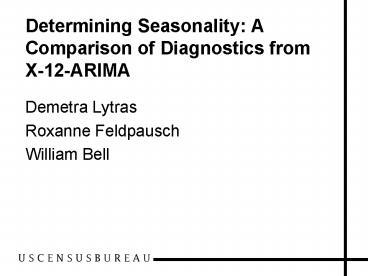Determining Seasonality: A Comparison of Diagnostics from X12ARIMA - PowerPoint PPT Presentation
1 / 32
Title: Determining Seasonality: A Comparison of Diagnostics from X12ARIMA
1
Determining Seasonality A Comparison of
Diagnostics from X-12-ARIMA
- Demetra Lytras
- Roxanne Feldpausch
- William Bell
2
Disclaimer
- This report is released to inform interested
parties of ongoing research and to encourage
discussion of work in progress. Any views
expressed on statistical, methodological,
technical, or operational issues are those of the
authors and not necessarily those of the U.S.
Census Bureau.
3
Purpose
- To evaluate the properties of diagnostics
available in X-12-ARIMA for detecting seasonality
(to determine if a series is a candidate for
seasonal adjustment)
4
Overview
- Definition of diagnostics
- Nonseasonal series
- Fixed seasonal effects models
- Airline models
- Conclusions
5
Tests for Seasonality
- D8 F test for stable seasonality
- M7
- Spectrum of the differenced transformed original
series - c2 test for fixed seasonal effects
- Extension to Fmb test (not in X-12-ARIMA)
6
Notation
- Assume monthly data, changes for quarterly data
are clear
7
D8 F Test Assuming Stable Seasonality
- H0 m1m2m12
- H1 mp ? mq for at least one pair (p,q)
- where
- m1,,m12 are the monthly means of the
seasonal-irregular (SI) component (the detrended
series)
8
D8 F Assumptions
- The SI ratios are independently distributed as
N(mi,?2) - Problems Estimated SI ratios are actually
dependent and heteroscedastic (higher variance
near the ends) - Traditionally attempted solution use 7 as
critical value
9
M7
- where
- Fs D8 F statistic for stable seasonality
- Fm D8 F statistic for moving seasonality
- Note M7 lt 1, series is seasonal
10
Spectrum of the Differenced Transformed Original
Series
- To determine seasonality, look for peaks at
seasonal frequencies 1/12, 2/12, 3/12, and 4/12 - A peak of six or more stars is considered
seasonal where one star is 1/52nd of the spectral
range in decibels - Used default start, estimated spectrum based on
last 8 years of data
11
c2 Test for Fixed Seasonal Effects
- Fit a regARIMA model with
- Fixed seasonal effects
- Nonseasonal ARIMA model
- Use results of the c2 test for fixed seasonal
effect regression coefficients
12
Fixed Seasonal Effects Regressors
13
c2 Test for Fixed Seasonal Effects
- where is the vector of fixed seasonal effect
regression parameters - Compare to
14
c2 Test for Fixed Seasonal Effects Assumptions
- c2 distribution (under H0) holds exactly only if
the ARMA parameters and the innovation variance
s2 are known - Problem Need to estimate the parameters
- Attempted solution use model-based F test to
correct for the estimation of s2 - Still need to estimate ARMA parameters
15
Estimates of s2
16
(No Transcript)
17
(No Transcript)
18
Extension to Model-based F test for Fixed
Seasonal Effects
- where
- is the chi-squared statistic from
X-12-ARIMA - k is the number of fixed seasonal effects
regressors (k11 for monthly data) - r is the total number of regression variables
19
Methods
- Simulate nonseasonal series to determine
significance levels of the diagnostics - Simulate seasonal series to determine the power
of the diagnostics
20
Methods - Nonseasonal Series
- Simulated 10,000 monthly series with a length of
20 years for each of the following models - ARIMA (0 1 0)
- ARIMA (0 1 1), with ? 0.3, 0.5, and 0.8
- ARIMA (1 1 0), with ? 0.3, 0.5, and 0.8
21
X-12-ARIMA Settings
- Model Correct ARIMA model (estimated parameters)
seasonal regressors - Forecasts 2 years
- Adjustment Type additive
22
(No Transcript)
23
(No Transcript)
24
Methods Seasonal Series
- Simulated series with
- Fixed seasonal effects
- Airline series
- Applied seasonality diagnostics
- D8 F, M7, Spectrum used size adjusted critical
value - Fmb
25
Fixed Seasonal Effect Series
- Added fixed seasonal effects based on two real
series to the nonseasonal simulated series
26
Seasonal Factors
27
Fixed Seasonal Effects
- Simulated 1,000 series from each of the following
36 models - Two sets of base seasonal factors
- Rescaling of base seasonal factors small,
medium, and large (compared to the irregular) - Six (0 1 1) and (1 1 0) nonseasonal models
28
(No Transcript)
29
(No Transcript)
30
Methods Airline Series
- Simulated 1,000 series from each of the following
48 models - Seasonal ? 0.6 and 0.9
- Nonseasonal ? 0.3 and 0.8
- Length of 10 and 20 years
- Starting values
- Zeros
- One of two sets of values based on real series
- Innovation variance 1 and a smaller number
31
Results Airline Series
- Fmb test found 99 - 100 of the series seasonal
- M7, D8 F and spectrum peaks found 89.2-100 of
the series seasonal
32
Conclusions - D8 F, M7 and Spectrum Peaks
- Significance levels vary greatly depending on the
model - Power is equal or lower than that of the Fmb test
for fixed seasonal effects
33
Conclusions c2 and Fmb Tests for Fixed Seasonal
Effects
- The c2 test was slightly oversized
- This is corrected by Fmb, whose significance
levels are consistently close to the stated level
of the test - Fmb has higher power than the M7, D8 F and
spectrum peaks for most models
34
Contact Information
- Demetra.P.Lytras_at_census.gov
- Roxanne.Feldpausch_at_census.gov
- William.R.Bell_at_census.gov






























